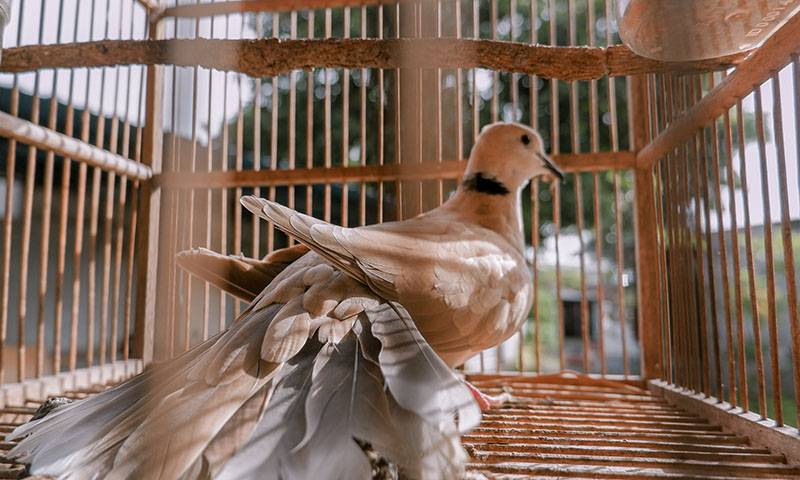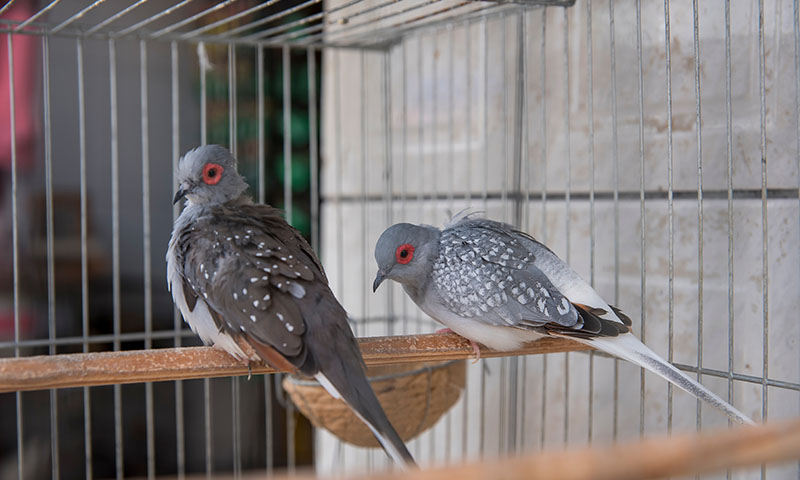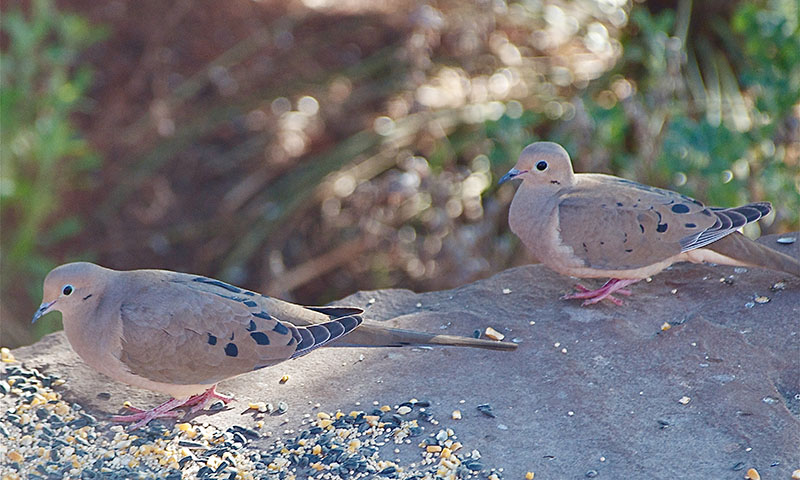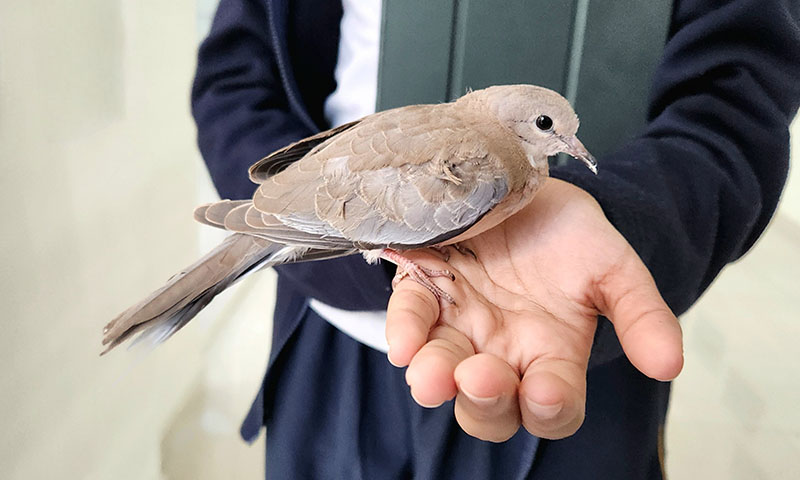Everything You Need to Know About Pet Doves
If the soothing, cooing sounds of a dove don't woo you, their gentle, calm demeanor will. These social birds make wonderful pets that can form strong bonds with their human companions.
They also build close connections with other doves, lovingly preening each other's feathers and making soft noises to communicate happiness. So, you might consider adopting a pair.
We turned to avian expert Veronica Villanueva, DVM, medical director of VEG ER for Pets of Anaheim Hills in California, to learn even more about keeping doves as pets.
"Doves are relatively low-maintenance compared to other pets, making them ideal for bird lovers," she shared.

Ringneck dove in an aviary.
What Colors Are Pet Doves?
Pet bird lovers might be surprised to learn of the approximately 300 species of doves, which can alternatively be called pigeons. Popular varieties kept as pets include the ringneck dove, diamond dove, or Barbary dove.
Pet doves come in a range of colors and markings, Villanueva explained.
"Common species like the mourning dove are typically grayish-brown with subtle spots, while the ringneck dove has a distinctive black crescent on its neck. Other varieties can be white, cream, or even pastel shades, depending on the breeding," she elaborated.
What Sounds Do Pet Doves Make?
Pet doves vocalize in several ways. The most popular sound, a soft cooing, indicates contentment and happiness. Other gentle chirps represent relaxation.
However, if your pet dove makes a sharp, loud noise uncharacteristic of its usual behavior, this may indicate pain or upset, Villanueva explained. Doves, unlike parrots, do not squawk, talk, or screech, making them ideal for households that prefer (or need) a quiet environment.
She says learning which sounds your pet makes and when can help you better respond to your pet's needs.
"Regular veterinarian check-ups are essential for maintaining a dove's health," Villanueva said. These visits offer an opportunity for your avian veterinarian to not only do a physical check but also answer your questions about your pet's behaviors, including vocalizations.

A pair of diamond doves in their aviary.
How Big Are Pet Doves?
An adult pet dove can measure 9 to 14 inches in length from head to tail tip. The size, of course, varies by species.
When it comes to choosing the perfect housing for your pet dove, or perhaps a pair since they do enjoy the company (and often monogamously mate for life), choose an aviary that allows for ample wing fluttering and short spurts of flight.
"Many people underestimate the vast social needs of doves. Doves thrive on companionship, so keeping them in pairs is often recommended. Additionally, some owners may not realize that doves require mental stimulation and can become bored without enough interaction or toys," Villanueva educated.
She suggests an aviary of at least 24" wide, 24" deep, and 36" tall for one bird with bar spacing no greater than a half inch to prevent escapes or injuries. Go larger if you're keeping a pair of doves, such as 32" wide, 21" deep, and 32" tall. She says to avoid aviaries made from galvanized metal (specifically zinc and lead) that can become toxic to pet birds.
When setting up your dove habitat, keep it away from drafty windows or doors and furnace vents since doves are sensitive to extreme cold or heat changes in their living environment.
And don't forget to include a few fun activities.
"In the wild, doves exhibit foraging behavior, or searching, for food. It is so important to provide your pet dove with puzzles or hiding places to encourage foraging for your pet dove as they would do in the wild," Villanueva shared.

A pair of mourning doves eating seed mix.
What Do I Feed My Pet Dove?
Doves require a balanced diet. Offer fresh water daily, seeds, pellet bird food, and fresh produce. Villanueva says pet doves can have up to 20% of their body weight in seed per day. The rest of their diet should come primarily from pellets, with fruits and vegetables given in moderation. She shares that doves (or any pet birds) should never eat avocado, chocolate, or caffeinated foods and drinks, as these can be toxic, even deadly, to birds.
Seed, pellets, & grit
Your pet(s) might enjoy Kaytee Supreme Dove Food, made with a blend of millet, milo, wheat, split green peas, canary grass seed, popped corn, safflower seed, and so much more. It's fortified with vitamins such as B12, E, and A, as well as minerals, to provide your pet optimal nutrition.
Unlike most pet birds, doves eat their seeds whole. Offering pet grit or pet gravel to your dove can help grind up the seeds in the digestive system. Try the Kaytee High-Calcium Grit Supplement for Small Birds, made from granite grit, oyster shell, and more to support the digestion of seeds.
Fresh produce
When it comes to fresh fruits and veggies, doves enjoy leafy greens (spinach, kale, romaine, etc.), diced apples (no seeds), broccoli florets, diced pears, and shaved carrots. Offer fresh produce in the aviary for an hour or two each day. When it starts to look wilted, remove it so your pet doesn't eat spoiled food.
Treats
And what about treats? Of course! Doves, just like us, enjoy a little snack now and then. You can try a cube of fresh fruit, such as peeled kiwi or melon, with your pet dove. Or, keep it simple, and hang a Kaytee Avian Blueberry Superfood Treat Stick in the aviary.
Do Pet Doves Like Toys?
Pet doves do indeed enjoy playing with toys, especially those that encourage foraging and exploration. This includes bird puzzle toys or those that hide food. Doves also like to glide on swings, explore the curves of natural wood perches, and nibble on chewable toys specifically created for pet birds.
Although you might consider allowing your pet dove(s) to play with your toddler's colorful toys, it's not a good idea.
"Avoid toys with small parts (plastic toys) that could pose choking hazards or those made from toxic materials (zinc, lead)," Villanueva added.

Barbary dove perched on a man's palm.
How Can I Bond with My Pet Dove?
When you first bring home your pet dove, allow him time to acclimate to you and his new home. For the first few days, avoid any touch to prevent a possible nip and keep noise to a minimum. This guidance also holds true for a pair of doves.
Create a daily routine that allows you and your bird(s) to bond over familiar tasks, including refilling fresh water, offering new food, and tidying up the aviary.
Then, spend time talking with him with a soothing, soft voice and offering a gentle hand to step up on. Regular play and training sessions can build trust and your bond with your bird. Doves can learn to recognize their owners and even come when called by name.
"Offering treats and allowing them to explore outside their aviary in a safe environment can also strengthen the bond," Villanueva added. Keep other pets (such as cats and dogs) in another room, close any windows and doors, and turn off ceiling fans when your pet dove enjoys time out of his aviary for playtime.
Love Birds? Consider a Pet Dove
If you're looking for a mellow pet, a dove checks all the boxes. They coo softly, gently snuggle into your neck during shoulder rides, and quietly enjoy your company.
Simply offer them a daily care routine, talk to them often, and serve up some tasty snacks — and you're sure to win over your pet dove.
Learn more about caring for your feathered friend in Bird Supplies - Getting Started.
